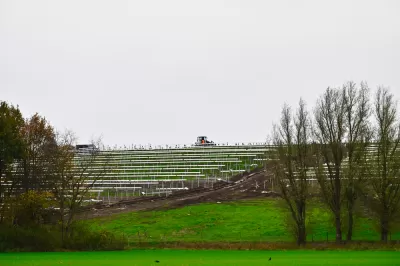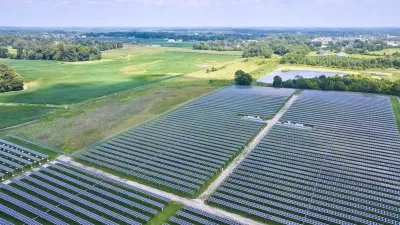Incentives aimed at brownfield development of renewable energy projects could give momentum to building solar farms on an underutilized property: closed municipal landfills.

A new tax credit created through the Inflation Reduction Act (IRA) could boost the construction of solar farms on shuttered landfills and other brownfield sites, which could reduce the impact of solar installations on virgin land and make renewable energy production accessible to more communities.
As Taylor Kate Brown explains in a Governing article, closed landfills offer unique challenges and unique opportunities. They are often owned by local governments, have strong sun exposure, and are unsuitable for other types of development, making them a logical site for energy production. “But placing solar modules on these sites requires a different kind of installation: a ballasted system that doesn’t drive foundations deep into the ground, avoiding piercing the landfill cap and unsettling the waste below,” Brown explains.
The success of subsidies and incentives for renewable energy production offered by state governments indicates that the federal tax break could encourage more brownfield development of clean energy projects. After Massachusetts created subsidies for renewable energy projects located on landfills, the state, which only has 7 percent of the nation’s landfills, became home to 52 percent of U.S. utility-scale landfill solar projects. Now, municipalities that previously rejected solar landfill projects due to cost or complications are revisiting the idea.
FULL STORY: Why Aren’t More Solar Farms Built on Municipal Landfills?

Trump Administration Could Effectively End Housing Voucher Program
Federal officials are eyeing major cuts to the Section 8 program that helps millions of low-income households pay rent.

Planetizen Federal Action Tracker
A weekly monitor of how Trump’s orders and actions are impacting planners and planning in America.

Ken Jennings Launches Transit Web Series
The Jeopardy champ wants you to ride public transit.

Rebuilding Smarter: How LA County Is Guiding Fire-Ravaged Communities Toward Resilience
Los Angeles County is leading a coordinated effort to help fire-impacted communities rebuild with resilience by providing recovery resources, promoting fire-wise design, and aligning reconstruction with broader sustainability and climate goals.

When Borders Blur: Regional Collaboration in Action
As regional challenges outgrow city boundaries, “When Borders Blur” explores how cross-jurisdictional collaboration can drive smarter, more resilient urban planning, sharing real-world lessons from thriving partnerships across North America.

Philadelphia Is Expanding its Network of Roundabouts
Roundabouts are widely shown to decrease traffic speed, reduce congestion, and improve efficiency.
Urban Design for Planners 1: Software Tools
This six-course series explores essential urban design concepts using open source software and equips planners with the tools they need to participate fully in the urban design process.
Planning for Universal Design
Learn the tools for implementing Universal Design in planning regulations.
Ada County Highway District
Clanton & Associates, Inc.
Jessamine County Fiscal Court
Institute for Housing and Urban Development Studies (IHS)
City of Grandview
Harvard GSD Executive Education
Toledo-Lucas County Plan Commissions
Salt Lake City
NYU Wagner Graduate School of Public Service





























